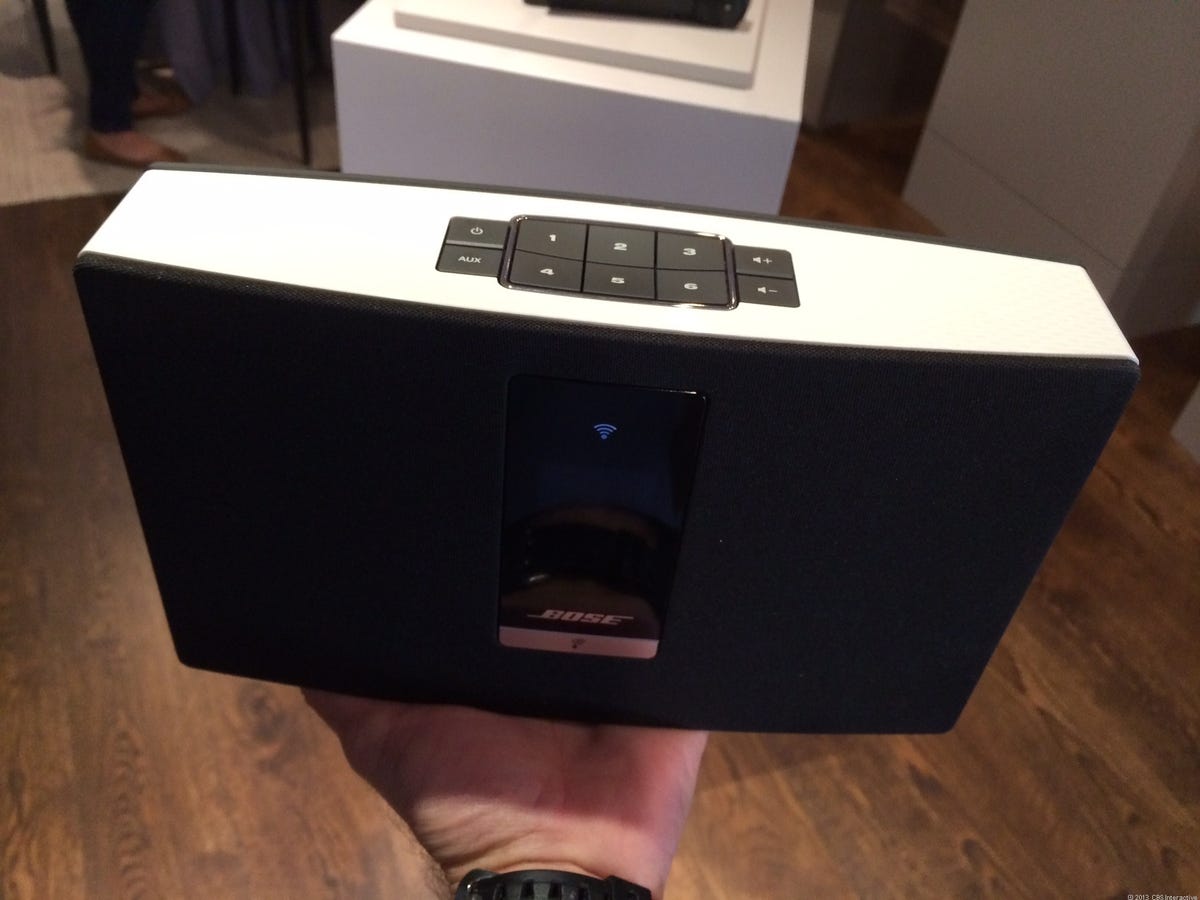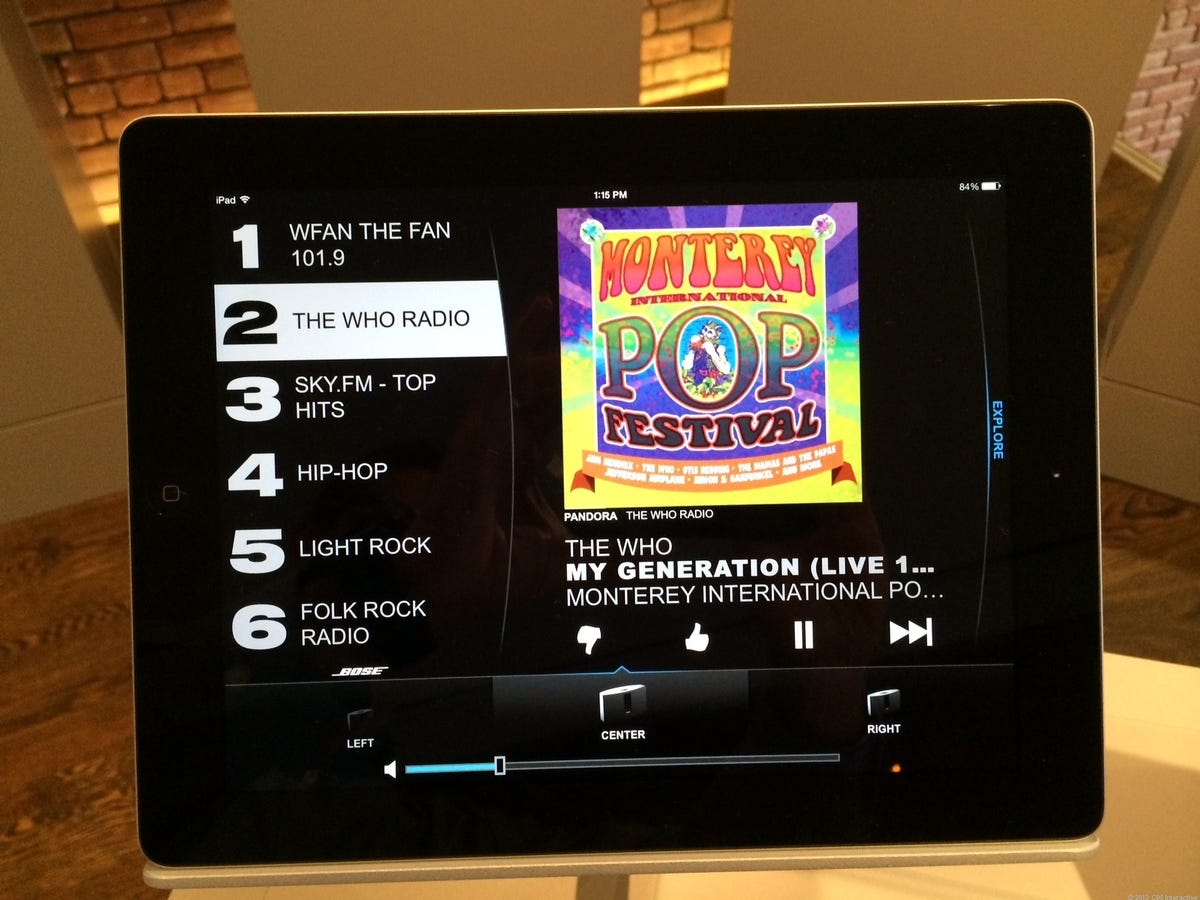

Now playing:
Watch this:
Bose takes on Sonos with SoundTouch, new multiroom wireless…
3:12
Over the years, Sonos, once a fledgling startup, has grown up to dominate the DIY multiroom wireless audio space. Now it has some serious competition.
Bose has officially unveiled a new line of Wi-Fi speakers under its new SoundTouch brand, which features simple setup and operation, and it’s definitely aimed at the same audience that Sonos has targeted.
The three new speakers that are available at launch — you can order them today — are the SoundTouch 30 ($699), a larger speaker designed for larger living spaces, and the SoundTouch 20 ($399) and SoundTouch Portable ($399), which are designed for somewhat smaller rooms. Bose will also introduce a Wave SoundTouch music system ($599) in December and other SoundTouch speakers and audio products in early 2014, signaling that it’s going all in on wireless audio.
Bose SoundTouch Wi-Fi audio systems (pictures)






I got an early demo of the system at a prelaunch event at a 8,000-square-foot townhouse in Greenwich Village (Bose had rented the townhouse out but it is on the market for $30 million). It shares many of the same traits as the Sonos system, but one of the differences is that it’s designed to work with your existing Wi-Fi network and doesn’t require a special “bridge” like Sonos does. However, that Sonos Bridge, which connects to the Ethernet port on your router, sets up a separate “mesh” wireless network that’s dedicated to streaming your audio and helps remove the hiccups typically associated with a Wi-Fi network, which aren’t incredibly reliable.
But Bose is pushing the simplicity of its system and how easy it is to set up “using your existing home Wi-Fi network” and nothing else. The other simplicity theme revolves around Bose’s use of “presets”; both the new speakers and new apps — Android and iOS devices are supported at launch along with Macs and Windows PCs — are equipped with buttons numbered 1-6. Each number corresponds to a preset in the app.
Using the apps, you can drag and drop specific Pandora radio stations onto a number to set it as a preset. You can also link one of the presets to the music library on your PC or a specific playlist.
To get your music up and running, you simply press one of the preset buttons that’s on the speaker or the included remote, or within one of the apps. Thus, the SoundTouch name.

David Carnoy/CNET
Sonos comparisons
Like Sonos, the speakers and apps will get software updates that add new features and services. At launch, I was underwhelmed with Bose’s line up of services. Beyond Pandora there’s nothing: no Spotifiy, no Rdio, no Deezer, no nothing. Sonos has a huge roster of service tie-ins, so Bose has a big hole to fill there.
The other thing you can’t do with the Bose SoundTouch speakers is combine two speakers to get stereo sound. That starts to get a little expensive when you’re combining $399 speakers to make a pair, but these types of speakers that have their drivers very close together typically feature little to no stereo separation, so it’s a nice option to be able to go stereo like you can with Sonos.
The SoundTouch 30 and SoundTouch 20 both offer Ethernet connectivity, so you can use a wired network connection if you want, and there’s an auxiliary input, so you can hook up an audio device to a speaker using a cable.
The Bose speakers aren’t equipped with Bluetooth (neither are the Sonos speakers), but they do support AirPlay streaming from iOS devices and PCs running iTunes. And like Sonos, you can stream music to a single room or have the same music play on all your speakers at the same time. You should be able to play different music sources in different rooms, but I didn’t test that feature yet.


David Carnoy/CNET
Sound demo
Bose did a sound demo in a controlled environment with hand-picked music tracks, and like most of Bose’s demos, the speakers came across in their best light and seemed to sound quite decent for their size. I suspect the SoundTouch 20 will match up just fine against the Sonos Play:5, which is about the same size and also retails for $399. Currently, Bose isn’t offering any SoundTouch speakers for less than $399, but you’d think that may change in the future with Sonos offering more-affordable speakers.
However, the next batch of SoundTouch products will be more expensive except for the SoundTouch Controller, a swankier remote that will come out early in 2014 for $99.
As I said, a Wave SoundTouch music system is coming in December for $599. And a SoundTouch Stereo JC (Jewel Cube) system ($1,199), a SoundTouch SA-4 amplifier ($499) for select Bose products (including outdoor speakers), and a SoundTouch wireless adapter for Lifestyle systems and VideoWave entertainment system will ship in “early 2014.” (Bose did demo that new stereo Jewel Cube system, which also includes a subwoofer, and, needless to say, it sounded better than the single-speaker systems.)
I’ll let you know how the launch speaker systems sound — and how smoothly they operate — as soon as we get our hands on some review samples. Naturally, it will be interesting to see how the market responds to having a second major competitor in the DYI multiroom wireless audio space. But one thing is clear from Bose’s announcement: it’s going all in on wireless audio; it’s not messing around and will surely put big bucks toward marketing the new SoundTouch line and telling everybody how easy it is to use.




